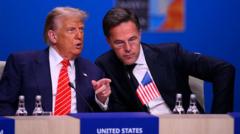In a move applauded by President Trump, NATO has committed to raising military spending to counter the threat posed by Russia, signaling a shift in the alliance’s approach to defense funding.
NATO's Historic Military Spending Commitment Reflects Trump's Influence

NATO's Historic Military Spending Commitment Reflects Trump's Influence
European allies respond to Trump’s call for greater self-reliance in defense with a significant budget increase.
June 25, 2025, The Hague – At a NATO summit concluding Wednesday in The Hague, European allies approved a substantial military spending commitment that aligns with President Trump’s long-standing demand for increased self-sufficiency in defense. This agreement marks a notable pivot in the alliance's focus as it responds to the perceived threat from a revitalized and militarizing Russia.
During the summit, NATO leaders agreed to increase their combined military spending to an ambitious 5 percent of national income by 2035, a significant rise from the current target of 2 percent. The new commitment includes 3.5 percent earmarked for traditional military resources—such as personnel, equipment, and weaponry—alongside an additional 1.5 percent dedicated to "militarily adjacent" initiatives, which encompass infrastructure improvements, health services, cybersecurity enhancements, and community resilience.
President Trump expressed satisfaction with the summit's outcomes, stating, “This was a tremendous summit, and I enjoyed it very much.” He acknowledged the essential role of U.S. support in European defense strategies, emphasizing that the presence of the United States is integral to their security framework. Trump's administration has often criticized NATO allies for what he describes as a reliance on U.S. military protection while underscoring a need for Europe to shoulder more defense responsibility.
Despite past rhetoric that implied a possible withdrawal of U.S. support from NATO, the summit's published communiqué reaffirmed the allies’ commitment to the collective defense principle codified in Article 5 of the NATO treaty. Historically, Trump has been hesitant to publicly endorse this crucial article, although he recognizes its importance in closed discussions.
The decision made at the summit represents a strategic shift within NATO in light of changing geopolitical dynamics, with members increasingly acknowledging the necessity for enhanced military funding to meet evolving security threats. As the alliance moves to bolster its defenses, the implications of this agreement may be profound for transatlantic relations and military preparedness in Europe over the coming decade.
During the summit, NATO leaders agreed to increase their combined military spending to an ambitious 5 percent of national income by 2035, a significant rise from the current target of 2 percent. The new commitment includes 3.5 percent earmarked for traditional military resources—such as personnel, equipment, and weaponry—alongside an additional 1.5 percent dedicated to "militarily adjacent" initiatives, which encompass infrastructure improvements, health services, cybersecurity enhancements, and community resilience.
President Trump expressed satisfaction with the summit's outcomes, stating, “This was a tremendous summit, and I enjoyed it very much.” He acknowledged the essential role of U.S. support in European defense strategies, emphasizing that the presence of the United States is integral to their security framework. Trump's administration has often criticized NATO allies for what he describes as a reliance on U.S. military protection while underscoring a need for Europe to shoulder more defense responsibility.
Despite past rhetoric that implied a possible withdrawal of U.S. support from NATO, the summit's published communiqué reaffirmed the allies’ commitment to the collective defense principle codified in Article 5 of the NATO treaty. Historically, Trump has been hesitant to publicly endorse this crucial article, although he recognizes its importance in closed discussions.
The decision made at the summit represents a strategic shift within NATO in light of changing geopolitical dynamics, with members increasingly acknowledging the necessity for enhanced military funding to meet evolving security threats. As the alliance moves to bolster its defenses, the implications of this agreement may be profound for transatlantic relations and military preparedness in Europe over the coming decade.























